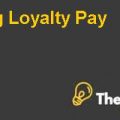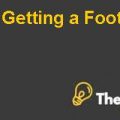Smith Family Financial Planning Case Study Solution
Introduction
The Smith family has been in the cash crunch because the family’s cash outflows are more than cash inflows. Since both husband and wife have combined annual income of $80,000 pretax. However, there is expanse are increasing rapidly, and they use a credit card that at the end of month incur huge interest expense. Meanwhile, in this situation, the family could not understand how their future planning should be and how their future goals could be achieved in given situations, where their expenses are over their income level.
Critical Success Factors
The family has been under the cash crunch, the reason is that their expenses are not controlled. Indeed their expenses exceed the income they have. On the other hand, they use the credit card when they are out of money, and at the end, the family ends up with a huge liability of interest payment on the credit card payment. Similarly, the family had no planning to how they should drive their expenses daily, and they had no goals and budget system at all.
Furthermore, the family had been using the most of the income in expenses, and it also has created many liabilities over them, whereas their home mortgages, their car is mortgaged, and they also have insurance planning is over the house and the cars. Therefore, from the situation, it is understood that controlling expenses is critical success factor one, and planning and budgeting are the second factor, and the third factor is making assets rather than liabilities.
Furthermore, increasing financial complexities has emphasized on managing the assets and liabilities. Therefore, these three factors Control expenses, planning and budgeting, and creating assets. These are critical success factors for the family. However, the creating assets rather than liabilities refers to the investment. On the hand, the family has been suffering the huge crisis, because it has frequently been relaying on the credit card as month approach to mid.
Problem Statement
How Smith family could achieve their goals in given cash crunch situation, in given situation, in which family is under short and ends up with huge interest payment on the credit card, and has many liabilities over.
Analysis
Balance Sheet and Income Statement
Smith’s family has huge liabilities whereas they had purchased the home on mortgage, and car as well. However, indeed, thevalue of assets is more than the liabilities. See Exhibit 1 that shows the assets and liabilities owned by the Smith family. However, if we analyze the situation, then it can be determined that Amber and Joel has $850 cash in hand, and bank balance of $1,300 with a saving of $2,200 only.
Furthermore, the Smith family is engaged in the mortgage loan in thehouse and car loan as well. On the other hand, it also has the credit card loan of $5,800. That is mean if the banksask for the credit card payment, and Joel would not be able to pay the amount of the credit card payment. Therefore, Joel and Amber are out of capital, which means they would not be able to meet their daily expenses.
Then, they would have single option to use their credit that incurs huge interest rate on average of 21%. That is hugerate. Indeed, at the end of year or month family pays interest rate payment, and could set off the debt, and it goes out control, and credit card debt is compounded monthly, that increases the interest rate payments for the card holders.
Meanwhile, the Smith’s family hasa good net worth of $173,626 that means that if family set off all its liabilities, then it would have good net worth amount in hand. However, it is determined that Amber and Joel not be managing their cash needs for thewhole month that create problems for them at the end of themonth and incurs huge interest expense as well.
Consequently, thefamily would only pay the interest rate payment on the credit card, and would not be able to pay the principle. However, Smith family is also suffering from the same situation, because on one hand family needs money at the end of themonth or mid of month for the daily wages and expenses to continue to the house and other expenses.
So, they use their credit card for wages and expenses, and at the end of themonth they could not pay back the payment, and interest rate applied is compounded monthly that increases the interest rate expense for the Smith family. Indeed, the family on average pays $2,088 in credit card payments. This is ahuge amount for the family to expense, whereas this amount could be used for the investment purposes.
On the other hand, the family is under the many liabilities one car loan of the amber’s which was mortgaged at $18,000 and remains $13,500 that is being paid annually $520, and it also pays house mortgage payment of $877. Furthermore, if sum up the all fixed spending that Smith family has to pay every month is around $1,602.
Meanwhile, the earnings of the family are $4,800 per month for the husband and wife. Consequently, the other expenses are almost variable and could be reduced or could be eliminated.For. example of the utility expenses, groceries, telephone, and mobile bills, car expenses, restaurant expenses.
Similarly, these expenses could be reduced, but not necessary to reduce all, at least the restaurant's expenses could be eliminated, and credit card expenses could also be eliminated completely. Meanwhile, some other expenses could be reduced so that family could save some money and avoid cash crunch.
Similarly, the cash crunch would make a family trap into the credit card payments, and it would need money for expenses, and they would use the credit card payments. However, if we analyze the current situation of the family, then the family is currently on the cash deficit in a given month, and it is in a deficit of $-536. So, in this situation family would need some cash in hand to manage the daily expenses.
Investment Analysis
Furthermore, this states that family is under the negative cash flows. However, the increasing complexities have made expenses out of control. On the hand, the family has been considering to invest $350 annually at the monthly compounded annual return of 5.5%. Furthermore, the family asks for the payment of $100,000.
However, the amount is unrealistic that could not be achieved with the small amount of $350. Meanwhile, if the family could invest the $350 monthly for the next nine years,then the Smith family could be able to get $62,000 at the end of the ninth year from the investment. Therefore, this might not work for the family, and could not meet with a goal.
However, Amber need this amount for the university education of her oldest son that would get admission in the university after nine years by completing his college studies. However, the return from the investment is good, because, if we calculate the future value of $350 series of 108 payments that would be equally paid every month would be $37,800.
Meanwhile, the investment would be compounded monthly at the rate of 5.5%. Therefore, the family would be able to get around double amount then it would have invested with the equal monthly payments. So, the total at the end of the ninth year would be $62,000, whereas the goal of amber is unrealistic to get around $100,000 from the same investment. Indeed, the return on the investment is much better and would be sufficient for the education of her elder son.
Registered Education Savings Plan
The Registered Education savings plan (RESP) is the type of trust where parents could contribute annually, and child would be beneficiary for the plan. However, the advantage of the RESP that it is not tax deductible, and tax would be deducted after the children withdraw the amount when plan has expired or terminated.
Furthermore, the amount would be taxed as per the age of child and his professional status or student. Therefore, he would take benefit of the tax. However, on the other hand, there is also disadvantage that the only cumulative contribution can be made for one beneficiary is $50,000 irrespective of contributors.
Therefore, in this situation family would not be able to achieve their goals of earning $100,000 from the investment. Meanwhile, it is not known how much investment would earn from the contributions made. Therefore, the family might be able to meet its goal and might need another way to achieve the goal.
Furthermore, it can be determined that if the family invest the same amount with an interest rate of 7% or 8%, it would not be able to get the desired amount at the end of the ninth year. However, if we analyze the situation, then it can be determined that if the family invest the $570 compounded monthly with the same interest rate of 5.5%, then the family could get their desired goal to achieve $100,000 at the end of the ninth year.
Meanwhile, if the family invests $455 monthly at the interest rate of 8%, then it would approach the $100,000 for a ninth year. However, as we have discussed the registered education savings plan could not fulfill the needs of the family. Because there is a limit on the maximum contribution of the $50,000 and the contributor does not know how much would beneficiary get at the time of expiration of termination of the plan.
Smith Family Financial Planning Harvard Case Solution & Analysis
Consequently, it can be said that if the Joel and Amber could work extra and save more money to meet their goals. Since the goal of the amber to get $100,000 is an unrealistic goal that could not be achieved with this little amount. However, the family should go for another alternative to ensure other earnings, and savings as well.
New Credit Card............................
This is just a sample partial case solution. Please place the order on the website to order your own originally done case solution.













